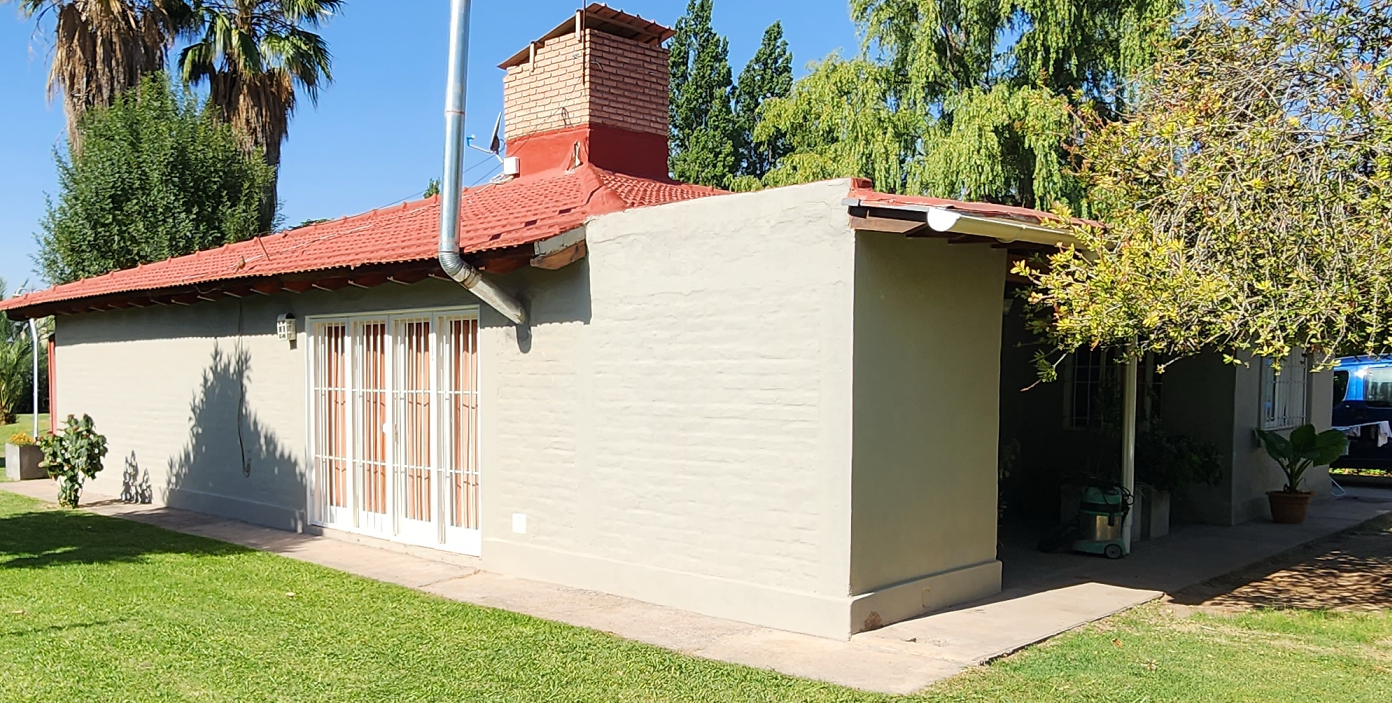Traditional green facades as a summer energy saving strategy in cities with an arid climate
DOI:
https://doi.org/10.18861/ania.2025.15.2.4007Keywords:
Green facades, Energy saving, Bioclimatic architecture, Sustainable developmentAbstract
This research evaluates the impact of Traditional Green Façades (FVT) on the energy demand of a single-family house representative of the residential typology of the Metropolitan Area of Mendoza in summer. The provision of FVT is compared with the use of a traditional insulation technology (Expanded Polystyrene-EPS). The study is structured in three stages: characterization of the opto-thermal properties of the PVT, determination by thermal simulation with EnergyPlus of the energy savings associated with their implementation, and the comparison of the results achieved with those derived from the use of EPS. It is observed that insulating the entire vertical envelope through the use of FVT and EPS, generates energy savings on summer days with high temperatures, in the order of 18.2% and 53.4% for FVT and EPS respectively. And on days with average temperatures, the savings range between 28.7% and 58.6% respectively.
Downloads
References
Blanco, I., Vox, G., Schettini, E., & Russo, G. (2021). Assessment of the environmental loads of green façades in buildings: a comparison with un-vegetated exterior walls. Journal of Environmental Management, 294, 112927. https://doi.org/10.1016/j.jenvman.2021.112927
Bustami, R. A., Belusko, M., Ward, J., & Beecham, S. (2018). Vertical greenery systems : A systematic review of research trends. Building and Environment, 146(August), 226-237. https://doi.org/10.1016/j.buildenv.2018.09.045
Caballero Montes, J. L., Ríos Ventura, F. G., & Alavéz Ramírez, R. (2024). Mejoramiento de la habitabilidad de la vivienda construida con fondos de remesas mediante estrategias bioclimáticas pasivas Habitability improvement of remittance funds built housing through passive bioclimatic strategies Melhoria da habitabilidade da cas. Anales de Investigación En Arquitectura, 14(1). https://doi.org/10.18861/ania.2024.14.1.3427
Coma, J., Pérez, G., de Gracia, A., Burés, S., Urrestarazu, M., & Cabeza, L. F. (2017). Vertical greenery systems for energy savings in buildings: A comparative study between green walls and green facades. Building and Environment, 111, 228–237. https://doi.org/10.1016/j.buildenv.2016.11.014
Correa, E., Ruiz, M. A., Canton, A., & Lesino, G. (2012). Thermal comfort in forested urban canyons of low building density. An assessment for the city of Mendoza, Argentina. Building and Environment, 58, 219–230. https://doi.org/10.1016/j.buildenv.2012.06.007
Djedjig, R., Bozonnet, E., & Belarbi, R. (2015). Analysis of thermal effects of vegetated envelopes: Integration of a validated model in a building energy simulation program. Energy and Buildings, 86, 93–103. https://doi.org/10.1016/j.enbuild.2014.09.057
Dong, Q. (2025). Energy Simulation-Based Design Optimization for Residential Buildings Using EnergyPlus. 9th International Conference on Green Energy and Applications (ICGEA), Singapore, Singapore, 2025, pp. 1-4. https://doi.org/10.1109/ICGEA64602.2025.11009325
EnergyPlus, Copyright (c) 1996-2021, The Board of Trustees of the University of Illinois, The Regents of the University of California, through Lawrence Berkeley National Laboratory (subject to receipt of any required approvals from the U.S. Dept. of Energy), Oak Ridge National Laboratory, managed by UT-Battelle, Alliance for Sustainable Energy, LLC, and other contributors.
Esteves Miramont, A., Gelardi, D., & Balter, J. (2009). Vivienda unifamiliar solar pasiva en el centro-oeste de Argentina. Avances en Energías Renovables y Medio Ambiente, 13. https://sedici.unlp.edu.ar/handle/10915/98570
Gill, S. E., Handley, J. F., Ennos, A. R., & Pauleit, S. (2007). Adapting cities for climate change: The role of the green infrastructure. Built Environment, 33(1), 115–133. https://doi.org/10.2148/benv.33.1.115
Karimi, K., Farrokhzad, M., Roshan, G., & Aghdasi, M. (2022). Evaluation of effects of a green wall as a sustainable approach on reducing energy use in temperate and humid areas. Energy and Buildings, 262, 112014. https://doi.org/10.1016/j.enbuild.2022.112014
Mazzocco, M. P., Filippín, C., Sulaiman, H., & Larsen, S. F. (2018). Performance energética de una vivienda social en Argentina y su rehabilitación basada en simulación térmica. Ambiente Construído, 18(4), 215-235. https://doi.org/10.1590/s1678-86212018000400302
Pérez, G., Coma, J., Sol, S., & Cabeza, L. F. (2017). Green facade for energy savings in buildings: The influence of leaf area index and facade orientation on the shadow effect. Applied Energy, 187, 424–437. https://doi.org/10.1016/j.apenergy.2016.11.055
Pujol, M. O., & Bisbal-grandal, I. (2019). DIVERSIDAD EN LA DISPERSIÓN: MORFOLOGÍA DE LAS ÁREAS RESIDENCIALES EN EL PERIURBANO DEL GRAN MENDOZA. Revista Urbano, 20, 46–63.https://doi.org/https://doi.org/10.22320/07183607.2019.22.40.03
Suárez, P., Cantón, M. A., & Correa, É. (2023). Comportamiento térmico estacional de fachadas verdes conformadas por especies trepadoras perennes en muros másicos orientados al oeste. Estudio de casos en zonas áridas. Cuaderno Urbano, 35(35), 83–105. https://doi.org/10.30972/crn.35356773
Suárez-Gómez, P. A., Cantón-Ivanissevich, M. A., & Correa-Cantaloube, Érica N. . (2024). Evaluación de estrategias de enverdecimiento vertical en clima árido: el caso de las fachadas verdes. Revista de Arquitectura (Bogotá), 26(2), 75-90. https://doi.org/10.14718/RevArq.2024.26.5014
Vargas-Hernández JG, J Zdunek-Wielgołaska. 2021. Urban green infrastructure as a tool for controlling the resilience of urban sprawl. Environment, Development and Sustainability 23: 1335-1354. https://doi.org/10.1007/s10668-020-00623-2
Vox, G., Blanco, I., & Schettini, E. (2018). Green façades to control wall surface temperature in buildings. Building and Environment, 129(September 2017), 154–166. https://doi.org/10.1016/j.buildenv.2017.12.002
Zhang, Y., Yang, Y., Zhang, L., Zhao, C., Yan, J., Liu, M., & Zhao, L. (2022). Seasonal variation in leaf area index and its impact on the shading effects of vertical green facades in subtropical areas. Building and Environment, 225(May), 109629. https://doi.org/10.1016/j.buildenv.2022.109629
Zhang, Y., Zhang, L., & Meng, Q. (2022). Dynamic heat transfer model of vertical green façades and its co-simulation with a building energy modelling program in hot-summer/warm-winter zones. Journal of Building Engineering, 58(March), 105008. https://doi.org/10.1016/j.jobe.2022.105008

Published
How to Cite
Issue
Section
License
Copyright (c) 2025 Pablo Suarez, Claudia Martínez, Érica Correa

This work is licensed under a Creative Commons Attribution 4.0 International License.
The journal and its contents are licensed under the Creative Commons - Attribution 4.0 International License (CC BY 4.0). It is possible to copy, communicate and publicly distribute its content as long as the individual authors and the name of this publication are cited, as well as the publishing institution (Universidad ORT Uruguay).

